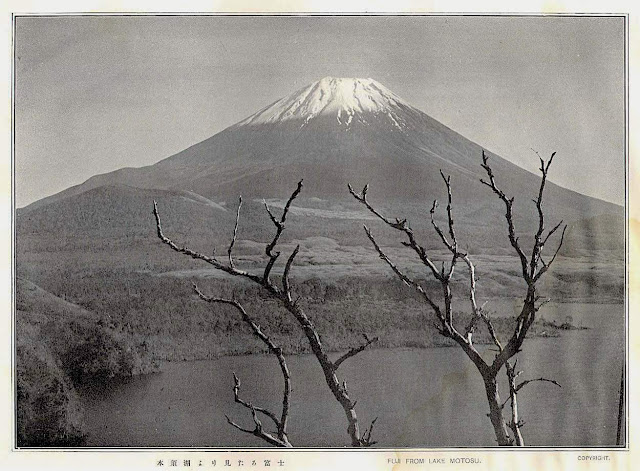GUYOSHŪ HAYAMI / 速水 御舟 (1894-1935)
Mount Hiei / 比叡山 (848m - 2,762ft)
Japan
In Mont Hiei, colors on silk, 1920, Tokyo National Museum
The mountain
Mount
Hiei / 比叡山 (848m - 2,762ft) is a mountain to the northeast of Kyoto,
lying on the border between the Kyoto and Shiga Prefectures, Japan. The
temple of Enryaku-ji, the first outpost of the Japanese Tendai sect of
Buddhism, was founded atop Mount Hiei by Saichōin 788 and rapidly grew
into a sprawling complex of temples and buildings that were roughly
divided into three areas:
The Saitō ("West Pagoda") area near the summit, and technically in Kyoto Prefecture.
The
Tōdō ("East Pagoda") area, also near the summit, where Enryaku-ji
Temple was first founded, and located just within Shiga Prefecture.
The
Yokawa ("Along the river") area near the northernmost end of Mount
Hiei. Due to its remoteness, as a temple complex it experienced periods
of revival and decline, starting with Ennin, later revived by Ryōgen and
made famous by the scholar-monk Genshin. Due to its position
north-east of Kyoto, it was thought in ancient geomancy practices to be a
protective bulwark against negative influences on the capitol, which
along with the rise of the Tendai sect in Heian period Japan (8th - 12th
centuries) meant that the mountain and the temple complex were
politically powerful and influential. Later schools of Buddhism in Japan
were almost entirely founded by ex-monks of the Tendai sect, who all
studied at the temple before leaving Mount Hiei to start their own
practices.
The temple complex was razed by Oda Nobunaga in 1571 to
quell the rising power of Tendai's warrior monks (sōhei), but it was
rebuilt and remains the Tendai headquarters to this day.
The
19th-century Japanese ironclad Hiei was named after this mountain, as
was the more famous World War II-era battleship Hiei, the latter having
initially been built as a battlecruiser.
The mountain is a popular
area for hikers and a toll road provides access by automobile to the top
of the mountain; there are also buses that connect the mountaintop to
town a few times a day. There are also two routes of funiculars: the
Eizan Cable from the Kyoto side to the connecting point with an aerial
tramway ("ropeway") to the top, and the Sakamoto Cable from the Shiga
side to the foot of Enryaku-ji. The attractions on the mountain are
quite spread out, so there are regular buses during the daytime
connecting the attractions. The center for these is the bus center, in
front of the entrance to the main temple complex at Tō-tō (東塔, "East
Pagoda").
The painter
Gyoshū Hayami (速水 御舟)
was the pseudonym of a Japanese painter in the Nihonga style, active
during the Taishō and Shōwa eras. His real name was Eiichi Maita. Gyoshū
was born in the plebeian downtown district of Asakusa in Tokyo. He
studied traditional painting techniques as an apprentice to Matsumoto
Fuko from the age of 15. When he was 17, his talent was recognized by
Shikō Imamura, who invited him to join the Kojikai circle of leading
young artists. With the revival of the Japan Fine Arts Academy (Nihon
Bijutsuin), Gyoshū became a founding member. He worked in many schools
of painting, including Yamato-e, Rinpa and Bunjinga, with his style
evolving gradually towards a detailed realism influenced also by his
studies of Chinese paintings from the Song dynasty and the Yuan dynasty.
His later works evolved further towards Symbolism. In 1914, Gyoshū
formed a group called Sekiyokai to study new styles of Japanese
painting. He had a leg amputated after being hit by a train in 1919, but
the incident did not affect his artistic output. He devoted himself to
creation, submitting numerous works to the Inten Exhibition, as well as
touring Europe in 1930. His flower and bird drawings in India ink
painting style and his portraits were especially well received by art
critics. His most famous work, Dance of Flames (炎舞) dates from 1925. It
was the first art work of the Shōwa period to be accorded the status of
Important Cultural Property (ICP) by the Japanese government's Agency
for Cultural Affairs. Gyoshū died suddenly from typhoid fever in 1935 at
the age of 40. Over 104 of his paintings were collected by the Yamatane
Museum in Tokyo. One of Gyoshū's works, Dance of Flames, was selected
as the subject of a commemorative postage stamp as part of the Japanese
government's Modern Art Series in 1979. In the year 1994, Gyoshū himself
was the subject of a commemorative postage stamp under the Cultural
Leaders Series by Japan Post.
_______________________________
2021 - Wandering Vertexes...
by Francis Rousseau








